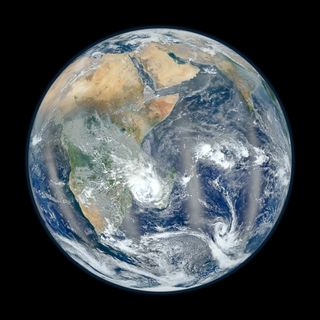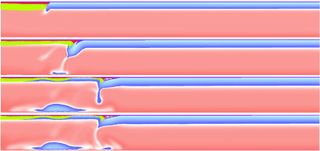
Gravity Moved Continents on Early Earth

Plate tectonics is the movement of the crust that builds mountains and opens ocean basins. How this gargantuan process got started on early Earth has been quite a mystery. Now, a new computer model suggests the motion started because of gravity: Whole continents flattened out under their own weight.
That's not how the Earth's crust gets jostled today. Currently the continents and ocean basins all float on the mantle, the layer beneath the crust, which flows like putty. Deep parts of the mantle heat up, and rise, and as they do they cool down, sinking again, creating huge circular currents. The currents push and pull the tectonic plates across Earth's surface.
When plates smash into each other, they make mountains like the Himalayas, and where they spread apart, molten rock bubbles up and makes new crust, as in the Mid-Atlantic Ridge. Crust is recycled at subduction zones, like the one that marks the "Ring of Fire" in the Pacific Ocean, where it sinks back down into the mantle. [In Images: How North America Grew as a Continent]
But early in Earth's history, the mantle was hotter, and perhaps too hot to latch onto the continents — it wasn't viscous enough to "stick" and impart much force. In addition, the continental and oceanic crust was thicker and would have been of similar buoyancy because of the additional heat from below. Plates would have just been immobile — they wouldn't subduct or move much. Only when the mantle cooled could it generate enough force to get the motion going — think of the difference between sliding over water and sticking to honey. That's why most geologists think current plate tectonics started after the mantle's temperature dropped, said Patrice Rey, an associate professor at the University of Sydney and lead author of the new study.
Gravity moves Earth
However, there are bits of rock called xenoliths that are found in ancient continental plates (cratons), which are some of the oldest rocks on Earth. They show evidence of repeated melting and cooling, in a layered structure. The new computer model explains how such layered rocks can appear on a young, hot Earth, even without modern plate tectonics, and end up in the cratons.
Instead of subduction driven by the moving mantle, the early rocky plates that made up the crust of our planet began spreading out like melting cheese and bumping up against other plates along their edges. The result was some plates sliding over the others, causing the plate on the bottom to dive into the mantle, or subduct. [Infographic: Tallest Mountain to Deepest Ocean Trench]
Sign up for the Live Science daily newsletter now
Get the world’s most fascinating discoveries delivered straight to your inbox.

As the plates spread out under their own weight, they would partially melt on the bottom, since they'd be thinner and easier to heat from below. Rey and his team estimate continents' bases could go from being about 140 miles (225 kilometers) down to about 46 miles (74 km). That thinning of the crust brought up more mantle material. The mantle material cooled and hardened, becoming crustlike, accreting on the ancient plate.
For up to 150 million years, gravitational spreading could have driven early plate tectonics – it was getting the ball rolling for later plate tectonic activity.
The spreading in the new model occurs because the ancient continents and the mantle just underneath were warmer, by about 360 degrees Fahrenheit (200 degrees Celsius) in the lower layers, down to about 100 miles (160 km) below the surface. That makes it more ductile – by comparison to today's crust it would have been rather soft.
"The gravitational force in a geological context has the same origin as the force responsible for the spreading of a piece of Camembert under its own weight," Rey told Live Science. A piece of the creamy cheese will, on a warm day, spread out and flatten, even though it won't melt.
Gravitational spreading is still a force in geology today, Rey said, though it isn't as prominent. "On the present-day Earth, the gravitational force … explains the occurrence of extensional deformation in the Tibetan plateau, which tends to spread laterally."
There is still work to be done – it's a computer model – but Rey thinks it goes some way to help explain the composition and structure of the current crust.
The researchers, including Rey, Nicolas Colticeat the University of Lyon and Nicolas Flamentat the Institut Universitaire de France, detail the work today (Sept. 17) in the journal Nature.
Follow Live Science @livescience, Facebook & Google+. Original article on Live Science.

Most Popular



